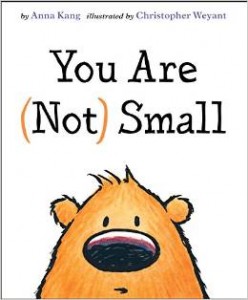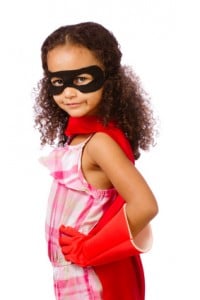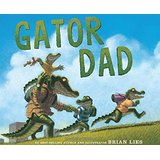 Here in Florida, June conjures thoughts of hurricane preparation. (Hurricane season begins on June first.) But for most of us, June brings thoughts of Father’s Day.
Here in Florida, June conjures thoughts of hurricane preparation. (Hurricane season begins on June first.) But for most of us, June brings thoughts of Father’s Day.
Today our first review is Gator Dad by author/illustrator Brian Lies. This delightful book depicts an extraordinary dad engaging with his children. The exuberant illustrations wonderfully fulfill the text. The story opens with dad’s shadow looming over his sleeping children. This iconic image usually evokes fear in kids but these baby gators are EXCITED not afraid. Clearly they associate dad with fun and when he invites them to “squeeze the day,” they are willing conspirators.
Trips to the grocery store, the park, etc all unfold in rollicking adventures. Kids will delight in the high jinks while adults will identify with the exhausted dad’s periodic suggestion that the little gators need a rest. Imaginative, descriptive language convey a mood of fun and affection. Gator Dad, is a book that every family can enjoy. What comes across clearly is the joyful bond that connects this dad with his kiddos.
 AQ* Lens Dad understands that making fun together intensifies the affection they feel for one another. This presupposition is an important concept for all families, especially adoptive families. Too often we can get caught up in balancing school, homework, behavior, etc that we forget to have fun. But fun is integral to attachment; it must be a strong feature of family life. Fun doesn’t have to mean $$$. This story shows dad having fun even while doing chores!
AQ* Lens Dad understands that making fun together intensifies the affection they feel for one another. This presupposition is an important concept for all families, especially adoptive families. Too often we can get caught up in balancing school, homework, behavior, etc that we forget to have fun. But fun is integral to attachment; it must be a strong feature of family life. Fun doesn’t have to mean $$$. This story shows dad having fun even while doing chores!
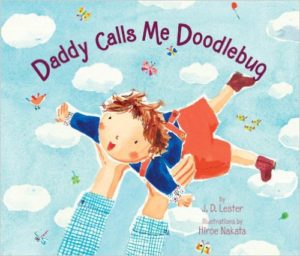 In the board book, Daddy Calls Me Doodlebug little ones–human and animal–announce the pet names their fathers call them. Each spread affirms the connection between child and parent. Children delight in knowing their father “sees” them and enjoys spending time with them. The nick names bestowed by the dad’s hold a story-within-a-story. This invites conversation between the reader and the child which adds an extra layer of fun.
In the board book, Daddy Calls Me Doodlebug little ones–human and animal–announce the pet names their fathers call them. Each spread affirms the connection between child and parent. Children delight in knowing their father “sees” them and enjoys spending time with them. The nick names bestowed by the dad’s hold a story-within-a-story. This invites conversation between the reader and the child which adds an extra layer of fun.
 AQ* Lens The inclusion of multiple species helps convey the idea that families can look different from one’s own and still be a family that love and and care for and about one another. It also offers a way to talk about how each creature–like each person–is unique and has talents and abilities of their own.
AQ* Lens The inclusion of multiple species helps convey the idea that families can look different from one’s own and still be a family that love and and care for and about one another. It also offers a way to talk about how each creature–like each person–is unique and has talents and abilities of their own.
Daddy Calls Me Man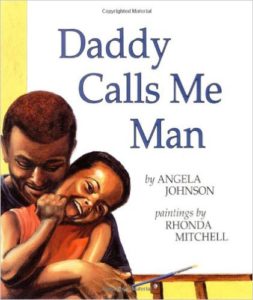 written by Angela Johnson and illustrated by Rhonda Mitchell depicts a happy, functioning family. The cover shows Noah and Ad sharing a deep belly laugh which appeals to the reader and makes one want to turn the page for more.
written by Angela Johnson and illustrated by Rhonda Mitchell depicts a happy, functioning family. The cover shows Noah and Ad sharing a deep belly laugh which appeals to the reader and makes one want to turn the page for more.
The illustrations are wonderful, full of energy and radiating emotion. The story opens with a spread of shoes: “Big shoes… all I want is big shoes.” Clearly the little boy aspires to fill his papa’s big shoes. Noah imagines many ways in which he can walk in shoes.
At day’s end nestled under his bed covers, Noah peers at the moon, thinking big thoughts “Asking why…” Perhaps he trying to figure out how to make room for his new baby sister. The story concludes with a spread featuring the boy standing beside his father who is seated at an easel. Obviously, dad is an artist, Behind them on the wall are several of the illustrations that appeared throughout the story. This is a delightful surprise which explains the various “styles” of art that grace the pages. Daddy Calls Me Man evokes a warm and tender mood that captures the blessing of family.

AQ* Lens: This story pictures an African-American family that is happy and successful. It is not an “issues” book. It’s simply about joyful moments in the ordinary parts of a family’s days. The dad is an artist–a novel choice of occupation to be included in a children’s story. One of the things I like best about this book is that it shows a family being happy, being ordinary. This is an important message to children of color. All too often the stories focus exclusively on the struggle, on poverty, on the urban experience. It is refreshing to see this family of color simply being family.–Gayle H. Swift, “ABC, Adoption & Me: A Multicultural Picture Book”
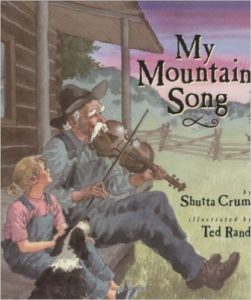 In some families without a dad, granddad serves as the primary loving father figure, so I’ve included My Mountain Song in this post. This story captures a distinct, rural flavor as a child visits here grandparents’ farm. Brenda Gail is looking forward to her stay–no pesky little brother to trail her, no big one to boss her around. But life delivers surprises–in the form of her cousin Melvin–and spoils the little girl’s plans. He teases her. They fight and Brenda Gail ends up injuring her granny’s favorite chicken.
In some families without a dad, granddad serves as the primary loving father figure, so I’ve included My Mountain Song in this post. This story captures a distinct, rural flavor as a child visits here grandparents’ farm. Brenda Gail is looking forward to her stay–no pesky little brother to trail her, no big one to boss her around. But life delivers surprises–in the form of her cousin Melvin–and spoils the little girl’s plans. He teases her. They fight and Brenda Gail ends up injuring her granny’s favorite chicken.
Guided gently by wise but firm grandparents, there’s a lovely life lesson tucked into the story about unexpected consequences following impulsive choices. In the end the two children make peace. They come to understand the importance of becoming one’s best and true self, of learning to sing one’s “mountain song.”
AQ* Lens  In addition to the obvious affection that the grandparents have for their grandchildren, they also have standards and traditions which they cherish. This offers an easy digression to the diverse traditions of both of a child’s families–birth and adopted.
In addition to the obvious affection that the grandparents have for their grandchildren, they also have standards and traditions which they cherish. This offers an easy digression to the diverse traditions of both of a child’s families–birth and adopted.
The plot point about impulsive behavior, unintended consequences and making amends can resonate with kids who have difficulty with impulsivity.

Diverse Children’s Books is a new book-sharing meme designed to promote the reading and writing of children’s books that feature diverse characters. This community embraces all kinds of diversity including (and certainly not limited to) diverse, inclusive, multicultural, and global books for children of all backgrounds.
We encourage everyone who shares to support this blogging community by visiting and leaving comments for at least three others. Please also consider following the hosts on at least one of their social media outlets. Spread the word using #diversekidlit and/or adding our button to your site and your diverse posts.
We hope this community will grow into a great resource for parents, teachers, librarians, publishers, and authors! Our next linkup will be Saturday, June 18th and on the first and third Saturdays of each month.
Most Clicked Post from Last Time
The most clicked post from our previous #diversekidlit is The Importance of Author’s Notes in Some Picture Books by Charnaie of Here Wee Read. Her post is a reflection of a recent conversation she got into with other book bloggers about the recent released Thunder Boy, Jr. by Sherman Alexie and illustrated Yuyi Morales. The questions raised by Charnaie and others serve to underscore the importance of author’s notes in helping readers to understand or even interpret a story.
#DiverseKidLit is Hosted By:
Want to be notified when the next #diversekidlit linkup goes live? Click here to join the mailing list. Interested in joining as a host or an occasional co-host? Contact katie at thelogonauts.com.
(Never participated in a linkup before? Please click here for a more detailed step-by-step.)
 Every one of us knows the pain of separation from someone we love. Children experience maternal separation with particular pain. From the moment of parting through to the long-anticipated reunion, their emotions spin. You Weren’t with Me by Chandra Ghosh Ippen Is a lovely, tender book that addresses the tumultuous, intense and complex feelings that children confront when they are separated from their mother.
Every one of us knows the pain of separation from someone we love. Children experience maternal separation with particular pain. From the moment of parting through to the long-anticipated reunion, their emotions spin. You Weren’t with Me by Chandra Ghosh Ippen Is a lovely, tender book that addresses the tumultuous, intense and complex feelings that children confront when they are separated from their mother.
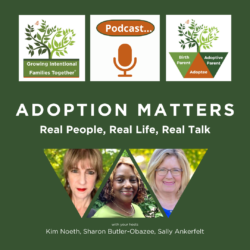 Listen to GIFT Family Services newest podcast, ADOPTION MATTERS: Real People. Real Life. Real Talk. This podcast looks at the adoption experience through the eyes of three of our adoption coaches: Sharon Butler Obazee, an adoptee; Kim Noeth, a birth mother, and Sally Ankerfelt, an adoptive parent.
Listen to GIFT Family Services newest podcast, ADOPTION MATTERS: Real People. Real Life. Real Talk. This podcast looks at the adoption experience through the eyes of three of our adoption coaches: Sharon Butler Obazee, an adoptee; Kim Noeth, a birth mother, and Sally Ankerfelt, an adoptive parent.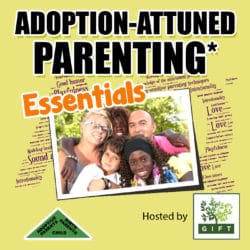 You can still listen to our original podcast, Essentials of Adoption Attuned Parenting.
You can still listen to our original podcast, Essentials of Adoption Attuned Parenting.

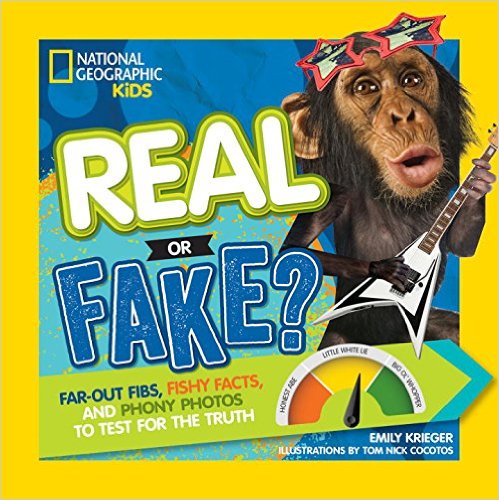




 In some families without a dad, granddad serves as the primary loving father figure, so I’ve included
In some families without a dad, granddad serves as the primary loving father figure, so I’ve included 


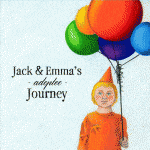


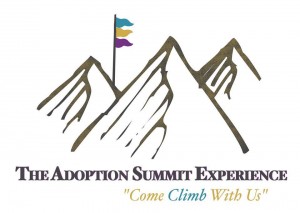
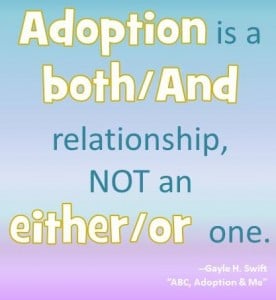
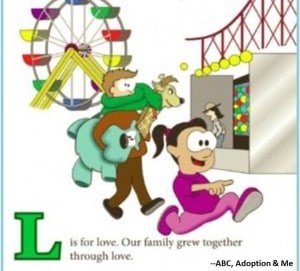
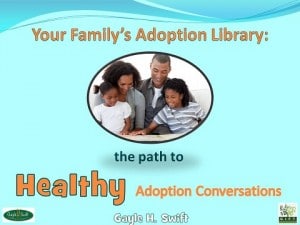
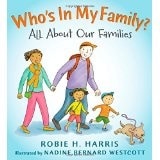
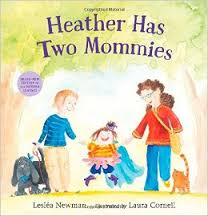
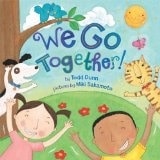


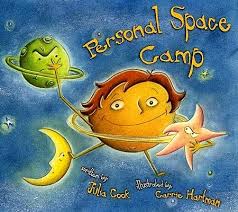 One excellent resource is a marvelous book by Julia Cook titled,
One excellent resource is a marvelous book by Julia Cook titled, 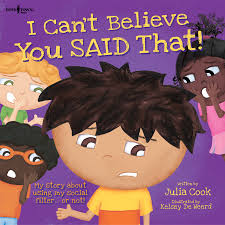 Julia Cook has written several other books that delve into the confusing world of social cues and interaction. One that is also quite helpful is,
Julia Cook has written several other books that delve into the confusing world of social cues and interaction. One that is also quite helpful is, 